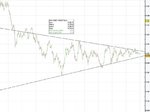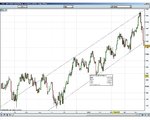Housing slowdown behind rise in inflation:
Perverse methodology could be distorting view of inflation, economists say.
Beneath the surface of rising core consumer prices over the past two months lies a disturbing trend: The slowing housing market is actually making inflation look worse, economists said.
The housing sector makes up 40% of the consumer price index, which increased 0.6% in April. Core prices, which exclude food and energy but which include shelter costs, rose 0.3%, spooking financial markets with an inflation scare.
Here's how it worked:
In the heady days of the booming housing market, more people were buying homes, and fewer were renting, economists said. Supply and demand kept rents comparatively low, and inflation appeared to be contained -- despite the run-up in home prices. But this virtuous circle is now reversing.
With home prices remaining high and mortgage rates rising, more people are being priced out of the real-estate market and are instead looking to rent. This increased demand is pushing up rents.
At the same time, the supply of rental properties has been constrained, as many former rental properties have been converted into condominiums, said Mark Vitner, senior economist at Wachovia Corp.
"This dynamic, once it begins, is fairly sticky," said John Ryding, chief U.S. economist at Bear Stearns. "This raises the risk of higher inflation going forward."
Perversely, this slowdown in the market is also pushing up the costs of owning a home, at least, the cost as reported by the government.
The way the government computes the CPI has created a distortion that made inflation look tame when home prices were soaring, but is now making inflation look worse as price gains moderate. It's all because the government measures everyone's housing costs -- renters and homeowners by looking at rents, not at the cost of owning.
Housing prices do not figure directly into the CPI data, Vitner explains. The government recognizes that homes are not only shelter, but assets that add to individuals' wealth, just as stocks and bonds do.
To measure just the value of the shelter services and not the long-term value of owning the asset, the government essentially assumes that homeowners rent their homes to themselves, so it computes an implied rent called "owners' equivalent rent" by asking them how much their house would rent for.
Owners' equivalent rent "is a deeply unsatisfactory measure because it is a price that nobody actually pays," said Jan Hatzius, chief economist for Goldman Sachs.
"The recent slowdown in house price inflation not only fails to hold down the CPI, but it arguably acts to push up measured inflation," Hatzius said. "It's difficult for the Fed to make this argument explicitly, because they never talked much about this distortion when it worked to suppress measured inflation. Nevertheless, they are clearly aware of the distortion and will take it into account when judging the inflation outlook."
Steve Stanley, chief economist at RBS Greenwich Capital, said he expects owners' equivalent rent to increase 0.3% on a steady basis in the coming months.
This will translate into a lot of 0.25% gains in core CPI every month, meaning that the tipping point between a 0.2% increase and a 0.3% gain will be other categories like autos, apparel and hotel costs.
"As we have been saying, core inflation is going to blow through the top of the Fed's comfort zone over the next few months," Stanley said.
One glimmer of hope might be that the Fed's favored measure of inflation is the core personal consumption price data, which is released by the Commerce Department near the end of each month. Housing does not play such a large role in that index, economists said.



